MyPortugalHoliday.com
The best independent guide to Portugal
MyPortugalHoliday.com
The best independent guide to Portugal
Portugal’s airports in 2026; an independent and expert travel guide
Portugal has three main international airports: Lisbon (LIS), Faro (FAO) and Porto (OPO). These airports serve the entire country, offering numerous international flight routes, including many operated by the low-cost airlines. The islands of Madeira and the Azores each have their own airports with regular flights to mainland Portugal.
Recent years have seen significant investment in Portuguese airport infrastructure, with a new terminal building in Lisbon and a complete modernisation of Faro airport. While this investment has greatly improved overall capacity, the passenger experience hasn't always kept pace.
The low-cost airlines are still plagued with long queues and frequent delays, and passport control can be agonisingly slow at peak times. Often the terminals seem to prioritise shopping over travel amenities.
Overall, Portuguese airports are modern, and the arrival process is generally good, but do expect the departure process to be slow and tiresome - especially with the budget airlines. Always leave plenty of time when planning your return journey.
This guide provides an overview of Portugal's airports, along with practical tips and advice for travellers.
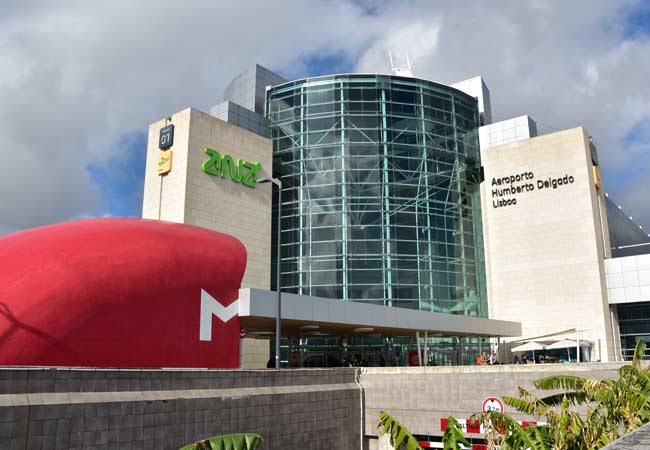
Lisbon Airport is the largest airport in Portugal
Which Portuguese airport to fly into?
The three main airports of Portugal conveniently cover the entire country.
For holidays in the Algarve, fly into Faro Airport. If you're visiting the central region of Portugal (including Lisbon, the Alentejo, and as far north as Coimbra), Lisbon Airport is your best option. For destinations in northern Portugal, Porto Airport is the ideal choice.
Mainland Portugal has a fourth international airport at Beja (BYJ). However, due to its infrequent use, it is not covered in this guide.
The interactive map below shows these three regions and the locations of the airports.
Insight: Portugal has an excellent and inexpensive train network connecting Porto, Lisbon and the Algarve. It only takes 2.5 hours to travel from Lisbon to Porto, or from Lisbon to the Algarve. The national train company of Portugal is Comboios de Portugal: https://www.cp.pt
Insight 2: There are direct buses from Faro Airport to Seville, making this is a suitable option if there are no direct flights to the small airport at Seville.
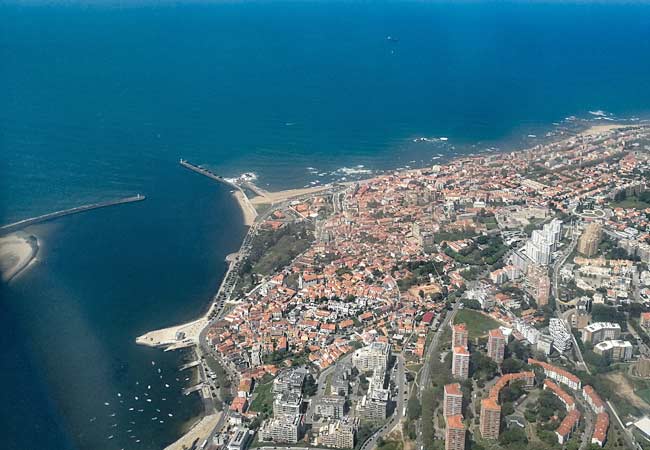
Looking down into Porto, where the Douro River meets the Atlantic Ocean and the Foz district
Important advice when using Portuguese airports
• For flights departing Europe (the Schengen region), passport control occurs after security and duty-free shopping. It's common for travellers to nearly miss their flights, as they don't expect this additional passport inspection after the gate has been announced. If you plan to shop, always allow extra time.
• In Lisbon, the low-cost airlines fly into Terminal 1 and depart from Terminal 2. The terminal building you arrive into may not be the same terminal building you depart from. Lisbon Terminal 2 is not connected to the metro; there is a free shuttle bus connecting Terminal 1 to Terminal 2, but this additional bus trip will make your journey by public transport about 15 minutes longer.
• There is very poor public transport from Faro airport. Always have something arranged before landing, otherwise, you will be forced to hire an expensive taxi.
• Madeira Airport occasionally experiences very strong cross winds that are funnelled through the mountains. When this happens, flights are diverted to Porto Santo, or even back to Lisbon. When flying to Madeira, always have travel insurance in case of diversions or cancellations.
• There is no airside connection between Lisbon Terminal 1 and Terminal 2. To reach Terminal 2 from Terminal 1, you will have to exit T1 (passport control and collect bags) and enter T2 (drop bags, pass through security and passport control). This whole process can be extremely time-consuming, and the low-cost airlines that depart from T2 will not put you on the next flight if you miss yours - they will charge you for a new ticket!
• When travelling with low-cost airlines, always book a morning or afternoon flight as there will be fewer delays or cancellations. The short turnaround time of the low-cost airlines means that delays build up during the day, and delays are generally worse at night.

The flight into Faro Airport flies over the city of Faro
The best airport in Portugal
If the Portuguese airport terminals were ranked for travelling experience during the peak season, they would be as follows:
1) Porto 2) Lisbon Terminal 1 3) Faro 4) Funchal 5) Lisbon Terminal 2
Porto is a modern airport, and the least hectic during the peak season. It provides the best experience for travellers using both international and low-cost airlines.
Lisbon Terminal 1 is dated, but has a large range of facilities and shops. Being so big, it can be a bit of a maze to navigate around. Faro Airport is modern, however it gets overly crowded during the summer and the lack of public transport is inconvenient for onward travel. Funchal is modern and easy to travel through. Lisbon Terminal 2 sums up everything bad about budget flying, and many passengers will have a poor experience. There can be endless waiting in lines and not enough seats at peak times.
For your trip to Portugal, the airport experience should only be a minor consideration - way behind the location you’re travelling on to and the cost/availability of flights. However, if we were planning a holiday all around Portugal, we would try to fly in and out of Porto Airport.
We would also recommend that you avoid flying through Lisbon Terminal 2 if you can, especially at peak times (Friday, Saturday and Sunday evenings).
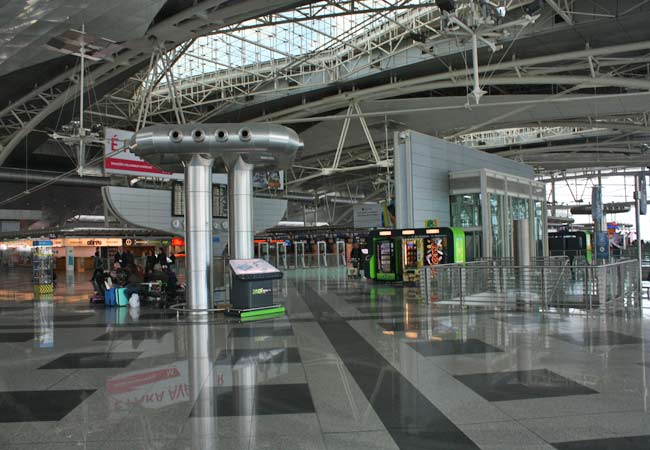
Porto Airport is modern and easy to travel through
Portuguese immigration - AIMA
The Portuguese agency that handles immigration is 'Agência para a Integração, Migrações e Asilo', often known by its acronym AIMA. AIMA replaced SEF (Serviço de Estrangeiros e Fronteiras) in December 2023, and SEF may still be referenced in older literature.
However, AIMA does not directly handle border control at airports, which is managed by the Public Security Police (PSP). For anything immigration related, AIMA should be the first point of reference and their website is: aima.gov.pt/pt

Portugal’s airports and onward travel from them
Lisbon
Lisbon Airport (LIS) is the main international airport of Portugal and handles the majority of routes from outside of Europe. It is busy year-round, but there are more flights and passengers during the summer.
There are two terminal buildings at Lisbon Airport. The larger Terminal 1 complex handles all arrivals and the departures of most flights. It has all the expected facilities of a large international airport, and while it may be a little dated it is a decent airport to pass through.
Terminal 2 was originally constructed as the terminal for domestic flights, but now handles the departures of the low-cost airlines (such as easyJet, Ryanair, Transavia and Wizz Air). The transition of the terminal from low-volume domestic flights to high-volume international flights means that the terminal is not really suitable for its role, and there are issues with queues, facilities and seating.
These are exacerbated at peak times or if a number of flights have been delayed. If departing from T2, always leave plenty of time to go through the terminal - and expect to be bored and standing in queues the entire time. There is a McDonald’s once past security, providing inexpensive food and drinks.
Lisbon Airport lies within the city limits and is conveniently connected to the red metro line. The metro is the recommended means of onward travel if your accommodation is based within the city, so there is rarely a need to pre-book an airport transfer. A single metro ticket costs €1.80 and is charged to the reusable ‘Navegante’ card, which costs €0.50 for the initial purchase.
If your holiday is in Cascais or Sintra then you may wish to book a transfer, however there are good train services to both. Head to Rossio station for Sintra, or Cais do Sodré station for Cascais. The main train station of Lisbon, for services to both the north and south of Portugal, is ‘Oriente’, which is connected to the red metro line.
If you do choose to take a taxi from the airport, always ensure that the meter is used so you don’t get overcharged.
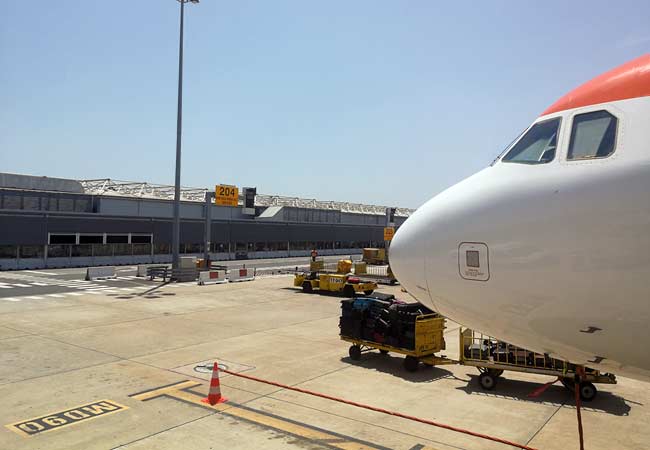
On arrival in Lisbon, the low-cost airlines disembark at Terminal 2 - but a bus will take you to Terminal 1
Porto
The north of Portugal is served by Porto Airport (OPO). This is a medium-sized regional airport that is popular with the low-cost airlines as an alternative to Lisbon, however the number of flights from outside of Europe is increasing. There is not generally a significant seasonal variation in numbers at Porto Airport, and it will be the least hectic to fly into or out of during the summer.
Being smaller than Lisbon Airport, there is considerably less walking involved - and Porto boasts far better facilities than Lisbon Terminal 2. If it fits your holiday plans, we recommend flying in and out of Porto.
Porto Airport is 12km north of the city centre and the metro is the best means of travel into the city. A single ticket costs €2 and is charged to the ‘Andante Azul’, a reusable public transport ticket that costs €0.60. The metro connects to the main train station of Porto, Campanhã, which offers services to all over the north of Portugal.
Faro
Faro Airport (FAO) serves southern Portugal, including the popular holiday destinations of the Algarve. The airport is similar in size to Porto, but passenger numbers fluctuate massively during the year - with fewer during the winter and vast numbers in summer (June to September). If you are traveling during summer, expect long queues for everything.
Faro Airport has very poor public transport links. There is just a single bus service to the city of Faro and a single summertime bus service to Albufeira, Portimao and Lagos.
Most visitors pre-book a private or shared transfer, or hire an expensive taxi or Uber/Bolt on arrival. There are many transfer companies in the Algarve, but the largest and most highly rated is Yellowfish. You can find their website here: www.yellowfis
Insight: There is a regional train service connecting most of the towns of the Algarve, but the nearest train station to the airport is in Faro. To get to the train station from the airport, you will need to catch the number 16 bus or use a taxi.
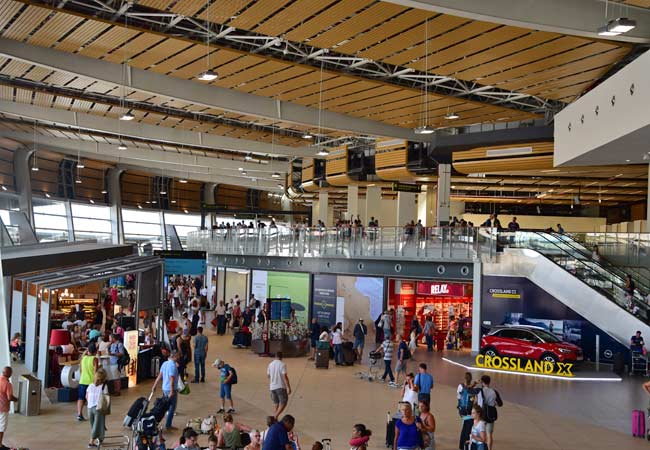
Faro airport in May, but it will be much busier in the summer!
Funchal, Maderia
The main international airport of Maderia is situated on the eastern side of the island, 17km from Funchal. There is a direct bus service called the Aerobus that takes 35minutes, costs €5, and is operated by Sociedade de Automóveis (SAM) www.sam.pt
The missed opportunity of Beja Airport
Beja Airport, located in the Alentejo region, represents a significant missed opportunity for Portugal's aviation infrastructure. This modern facility boasts the longest runway in Portugal at 3.4 km, capable of handling any known passenger or transport aircraft.
Despite its €33 million EU-funded civilian terminal that opened in 2011, Beja Airport remains largely unused, often referred to as Portugal's "ghost airport". The facility has the potential to serve as an excellent hub for low-cost airlines, potentially alleviating pressure on the busier airports in Lisbon and Faro.
The main obstacle to Beja Airport's success is its inadequate transport links. However, with improved rail connections, it could effectively serve both the Algarve and Lisbon regions. The distance from Beja to Lisbon (150 km) or Faro (120 km) is not insurmountable with efficient rail services.
Improving Beja's infrastructure and connectivity would likely have significantly less environmental and financial impact than constructing an entirely new airport near Lisbon.
Lisbon connections
If booking connections, ensure the flight is with the same airline (or alliance of airlines), so that if a flight is missed you can be booked on to the next available flight. Be very wary of booking a connection between Lisbon Terminal 1 and Terminal 2, as there is no airside connection. It takes a surprisingly long time to pass through immigration, collect bags and then catch a bus to Terminal 2.
Related articles: Lisbon airport





























